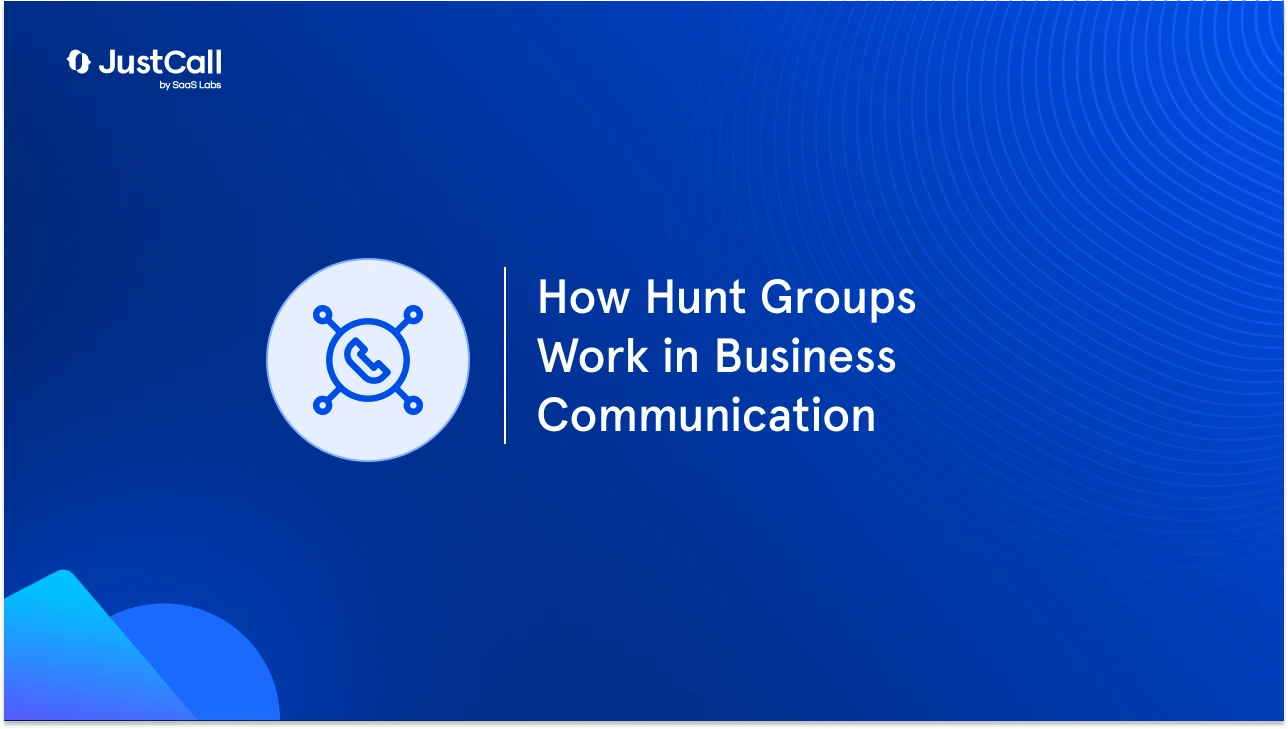Getting a phone system for your business is a great way to improve how you talk to your coworkers and customers. Even though you need a phone system to make and receive calls, it also has some excellent features to help you get the most out of your tech.
The ability to create and manage hunt groups is a perfect example of a robust and helpful feature. This article will walk you through the concept of a hunt group and everything else you need to know.
What is a Hunt Group?
A Hunt Group is an automated feature that allows businesses to distribute calls to groups of people within their organization. Incoming calls are made to a single phone number and re-routed to multiple phone lines or devices.
Essentially it saves the time of the consumer by quickly transferring calls to the available device and automatically redirects calls to the concerned team rather than being manually processed by a human.
If you run a business, which has several incoming calls, or several departments within the organization where customers constantly call to reach a particular platform, then the Hunt Group facility is for you.
It is important to make sure your customers reach the right department when they call without putting them on hold for long. This is where a Hunt Group plays a vital role!
It is a unique service that is a great value-add for your business if you have a small team that handles calls. You will be able to integrate 100% capabilities of hunt groups into your organization by collaborating with a telephony platform or service.
3 Types of Hunt Groups
Most phone systems let you choose from three types of hunt group assignments.
1.Linear Hunt Group
In a linear hunt group, calls are always sent to the line with the lowest number. It is also known as call forwarding for busy or no-answer lines. Calls are always sent to the first line unless it is already in use, in which case the second, third, and any other cables are tried.
Most small businesses with more than one line have phones set up this way. It is usually the least preferred method for automated call distribution systems that get a lot of calls. It is because calls will arrive at destinations still on the last call and, depending on the situation, may be the least ready to take the call.
It is an excellent way to get calls to the agent who is the most experienced or knows the most. Call prioritization can be done by giving the lower line numbers to the best agents at what they do.
2.Circular Hunt Group or Round Robin
In a round-robin hunt group, the calls are passed from one person to the next. If a call goes to line 1, the next call will go to line 2, and so on. When the last line of the hunt group is reached, the hunt starts over at the first line. Only sequences that are still busy on a previous call are skipped.
This method of call distribution tries to give calls to agent groups like sales organizations more evenly.
3.Most Idle Hunt Group
In most idle hunting, calls are always sent to the line that hasn’t been used for the longest. It considers how long the call taker has been busy versus how long they have been free. It is often used in call centers, where people answer calls, to ensure the work is evenly spread out.
How does a Hunt Group Work?
Now that you know what a hunt group is for, it’s time to look at how it works. A group can send out a call in 4 different ways:
1.Simultaneous Call
A simultaneous call is the first way. All the phones in the group will ring simultaneously when someone calls. The group’s members or operators can answer the call if they are available.
2.Regular Call
A Regular call is the second way. The hunt group calls the number at the top of the list. If this line is busy or no one answers the phone, the call goes to the following number on the extension list, and so on.
3.Longest Idle or Uniform Call
The third way is to use a “Longest Idle” or “Uniform” call. It happens when a call is sent to the phone that hasn’t been used the most. If this line is busy, the call will go to the following free line, and so on.
4.Circular Call
A circular call is the fourth way. The first call rings one phone. The second call rings the second phone in the group first, and so on for each line. It keeps happening until the end of the hunt. Group extensions are called. Then it goes back to the first line until someone picks up the phone.
If no one can answer any of these calls, the call will go to voicemail. Members can sign in and out of hunt groups so that phones don’t ring when no one is there to answer them.
If you are added to a hunt group, you can answer calls for a team and call your work number. If someone calls the group, your phone will let you know. Your screen will show that the call has been forwarded from the hunt group number, so you can tell if the call is to your work number or a group number.
How to Make Hunt Group (Step-By-Step)?
If you wish to create a hunt group, you can follow the steps mentioned below.
Step 1:Create a group by adding members
Step 2:Assign operators and phones
Step 3:Create business hours and set up call handling
Step 4:Select the type of hunting calls and execute.
Benefits of Hunt Groups
Using hunt groups can provide significant business benefits from an organizational and professional perspective. Let us look at the advantages of using hunt groups for your business:
- It can handle a high volume of calls
- This system works great for startups with just a few employees
- Hunt group schedules, especially recurring schedules, keep calls from going to voicemail
- Distributing calls ensures that all relevant calls are answered, which prevents urgent consumer concerns from being missed
- It’s also a great way to increase the chances that the caller will arrive at the right place and the right team will answer the call
- It gives your business a trustworthy, credible, organized, and professional look
How do Businesses Use Hunt Groups?
You must first know how to set up a group. First of all, you need the right tools. You’ll need a phone system, phone service, and a phone to work with this system. Next, you need a number that is given to you.
If you use a hosted PBX system, the administrator will set up the group and add members using their extension lines. Next, they’ll give the hunt group a phone number. Once this is done, you can log into the hunt group if you’ve been added as a member.
You can also set up other features and alerts, such as email to voicemail, greetings, and options for the menu. You can choose where a member stands in a group, how calls are split up and how long a call spends looking for available members.
Difference between Hunt Groups & Ring Groups
Hunt group vs Ring group: Few simple differences below –
| Hunt Groups | Ring Groups |
| In a hunt group, the client manages the phone calls. | In a ring group, all group members simultaneously manage the calls received. |
| Hunt groups allow certain groups in an organization to receive phone calls. | Ring groups are beneficial when a business receives a huge number of calls on a daily basis. |
| If the first person doesn’t receive the call in a hunt group, it gets redirected to the next receiver. This is the basis of ‘hunting’ a receiver during making a call. | In ring groups, all phones will ring simultaneously in ring groups until someone picks up the call. |
Conclusion
Hunt group is something that several businesses have been using all this while, but only a few of them were aware of what it actually is. With JustCall, it will take just a few minutes to set up hunt groups in your organization. Hunt groups are much more organized, personalized, and hence, the need of the hour for businesses. So, if your team is always on the phone, talking to clients, it’s time to create hunt groups in your office. This will give your employees and your customers better experiences related to your business.












